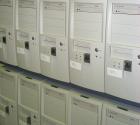Current Configuration
titania, ariel, puck, new oberon, umbriel, portia
titania and ariel each consist of 16 1100MHz Athlon CPUs with 256 MB of
memory each. puck is another 2 nodes, identical to the above. oberon
consists of 32 slightly (20%) faster systems. umbriel is identical to
oberon. portia is 2 nodes identical to oberon.
- 1100 MHz AMD
Athlon CPU (titania, ariel, puck),
1333 MHz (oberon, umbriel, portia)
- Asus A7V Motherboard (titania, puck),
Asus A7A266 Motherboard (oberon, umbriel)
- 256 MB CAS2 SDRAM (mix of ECC and non ECC)
- 20GB 7200rpm Western Digital hard drive
- 100Mbps Ethernet Cards - mix of:
- Intel EtherExpress (two on root node)
- 3Com 3C905B (eventually replaced with more Intel cards for
homogeneity)
- Floppy and CD-ROM drives
- Scyld Linux
- Built by Champaign Computer
|

|
Each cluster is controlled as a single root node, which is controlled much
like a standard Linux box. Computations are divided up and transferred
to the rest of the cluster by a single front end machine. The other machines
have no keyboard, mouse, or monitor; they only connect via the network.
All of the machines are connected through four 3Com SuperStack III 3300TM 24-port switches, each
with a Gigabit uplink and a matrix port for attaching additional switches,
and two 3300 III 3300MM, which have three matrix
ports to connect the other switches.
A breakdown of costs (at the time):
| Component | Cost Per | Count | Total Cost |
|
| PCs | (avg) $940.46 |
106 | $99,688.50 |
6 spares |
| Add. Network Cards | $50 |
4 | $200 |
| Ethernet Switches | (avg) $1,403.62 |
6 | $8,421.72 |
4x 3Com 3300TM
2x 3Com 3300MM |
| Shelving + Cables | $1200 |
| $1200 |
| Total | $109,510.22 |
old oberon (retired)
oberon originally consisted of 16 dual-400 MHz Pentium II CPU's with 256MB of
memory each.
- Dual 400 MHz Intel
Pentium II CPU's
- 256 MB 100MHz SDRAM
- 2.2 GB SCSI hard drive (9 GB on master node)
- CD-ROM and floppy drives
- Fast ethernet interface (second interface on master node, unused)
- RedHat Linux
- Custom built by VA Research
Each of these machines was connected, via switchbox, to a single shared
monitor and keyboard. They were connected to the building network via a
Bay Networks BayStack 350T
16-port fast ethernet switch, which connected to the building backbone.
As of February 2001, oberon has been retired. Its nodes were given modern
graphics boards (specifically the GeForce2 GTS), and
moved to researcher desktops. Each node is now a 3-D capable workstation.
Shared Resources
Both clusters are stored in industrial shelving units (five 36"x18"x85"
units, and one 48"x18"x85") and powered by a Best Power FERRUPS uninterruptible
power system.
History
- 1594: Oberon and Titania are king and queen of the fairies in Shakespeare's A Midsummer-Night's Dream.
- 1787: Titania and Oberon, the largest and second largest of Uranus's known satellites, are discovered.
- 1851: Umbriel and Ariel, the third and fourth largest of Uranus' known satellites, are discovered.
- 1986: Puck
and Portia,
two of Uranus' smaller moons, are discovered by Voyager 2.
- July 1998: First eight nodes, switch, etc. installed for oberon.
- August 1998: Additional eight nodes of oberon installed.
- August 2000: oberon retirement begins, as its nodes are moved to
desktops.
- January 2001: First eighteen nodes, switch, etc installed for titania.
- February 2001: Additional fourteen nodes installed for titania,
bringing total up to 32. puck is installed with 4 nodes. Old oberon cluster
retirement completed.
- April 2001: First sixteen nodes, switch, etc installed for the new
oberon cluster. An additional sixteen nodes have been ordered, and will
arrive within a few weeks.
- May 2001: Umbriel, a third cluster of 32 nodes, is ordered.
- June 2001: Second sixteen nodes of oberon and all of umbriel are
installed.
- August 2001: Half of puck is retired as desktops; the resulting
space is used to fit portia.
Performance
Using the molecular dynamics code NAMD we have
achieved these speedups on a 92,000 atom system on our clusters:
| CPUs |
1333 MHz Athlon |
| Sec/Step | Speed-Up | Efficiency |
| 1 |
10.54 | 1 |
100% |
| 2 |
5.45 | 1.93 |
96.7% |
| 4 |
2.83 | 3.72 |
93.1% |
| 8 |
1.52 | 6.93 |
86.7% |
| 16 |
0.83 | 12.70 |
79.4% |
| 32 |
0.47 | 22.43 |
70.1% |
Tutorials
The Theoretical Biophysics Group has given a tutorial for NCSA's Linux Revolution
Conference on 25 Jun 2001. The same tutorial was given on 19 Jun
2001. Materials from this tutorial are here.
Related Sites
|